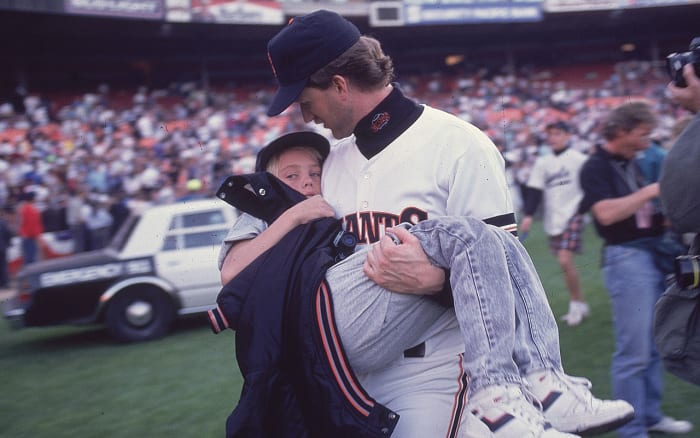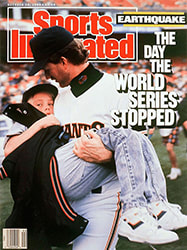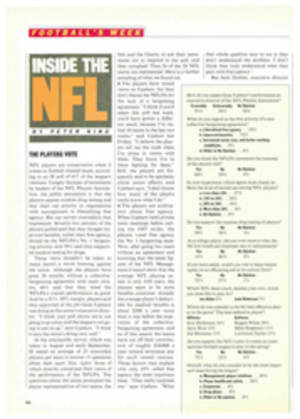When the World Series became 'A modest little sporting event'
Years from now, when someone asks me where I was when The Earthquake hit at 5:04 p.m. on Oct. 17, 1989, I'll be able to say, certainly without needing to refresh my memory, that I was in Candlestick Park, awaiting the start of the third game of the World Series between the Oakland Athletics and the San Francisco Giants. I realize, of course, that some 60,000 other people can truthfully say the same thing and that, as time passes, at least that many more will lie about being there, since that's the way it is with big events. People want to be where the action is.
But to tell the truth, Candlestick wasn't where the action was at all. And thank God for that. The maligned old bowl was jolted to its foundations, but when the quake had finished its dirty work, the Stick was still standing, which, tragically, is more than can be said for a section of the Bay Bridge, a mile-long stretch of the Nimitz Freeway in Oakland and 60 buildings in San Francisco's Marina district.
There was, in fact, something wholly unreal about being in the ballpark at that terrible moment. Before the quake struck, I was talking to a colleague in the upper-deck press seats about what another fine October day we were having in San Francisco and how television viewers, seeing all that sunshine, would surely never believe any more stories about Candlestick's being baseball's equivalent of a polar ice cap. I would once more have to explain to doubting visitors that unlike July and August, October in this city is generally warm, dry and still. Then, suddenly, it wasn't still anymore.
The entire stadium was reeling, and I watched as the television sets mounted on stands above the press tables swayed like giant cobras. "We're having a quake," I said with the studied nonchalance of a Bay Area native. When the rumbling finally ceased, some reporters, apparently regarding me as the resident disaster expert, asked what I thought this one would measure on the Richter scale. "Oh, maybe 5.4," I said, arriving at a figure which would indicate a tremor that was significant, but hardly, as it were, earthshaking. "Five-four, max."
That guess, I was soon to learn, was every bit as accurate as estimating Ty Cobb's career batting average at .225. This quake had hit 6.9 and was the largest in San Francisco since the 8.3 of 1906. But Candlestick fans couldn't have known that at the time, and when the shaking stopped, they let out an enormous cheer—in part, I'm sure, to demonstrate to outsiders their grace under pressure, and in part because they were just glad to be intact. Some even shouted, "Play ball!" But the scoreboard and the loudspeakers were off in Candlestick, and when police appeared on the field, the fans began to head for the exits in a manner both cheerful and orderly.
It was an odd moment. Here we all were in this huge concrete bowl, some of us perched nearly a hundred feet above ground, after being rocked by one of this country's biggest earthquakes on record, and we were acting as if we had been through nothing more extraordinary than a grammar school fire drill. As we left the stadium, a friend of mine said, "I've seen bigger crushes when someone at my house shouts, 'Let's eat!' at a family dinner." But none of us had any idea then how serious this thing was. By the time I was outside the stadium, the scare stories had already started: The bridges were all down, downtown was in ruins, thousands were dead, looting and rioting were widespread, the stadium was about to tumble down.
Even with all the wild rumors, I was convinced that conditions were not nearly as bad as they were being made out to be. I had been through enough earthquakes—even slept through a bunch of them—to know that they are invariably described, particularly by novices, as being much worse than they are. Earthquakes, for those who don't experience them regularly, are apparently the most frightening of all natural calamities, possibly because, unlike hurricanes, tornadoes and blizzards, they arrive with no advance warning. But from where I stood, behind Candlesticks centerfield stands, this one seemed no worse than the others. Five-four, max.
When we finally boarded a press bus to take us downtown, the driver told us we would be avoiding the Bayshore Freeway because of possible damage there and taking Third Street. Nothing unusual about that. A lot of experienced Giants fans routinely take Third Street to avoid traffic. But the driver advised us that because of the looting, bottle-throwing and even some shooting that had erupted in the mostly poor neighborhood, we should keep our heads below window level; I was beginning to believe the crazy talk was not so crazy. While our trip along Third was without violent incident, it was more than a little eerie, and even frightening, because all the lights were out. Downtown was even stranger, in an almost impenetrable darkness, recalling for me the blackouts of World War II during which, as a boy, I would peer excitedly from under the window shades in search of Japanese bombers. As we drove along, I could make out shards of glass coating the sidewalks. Entire blocks were cordoned off, and I could see fallen masonry in the street. Pedestrians—some not knowing where to go, others with no means of getting anywhere—huddled on street corners. Our driver, a true Samaritan, dropped his passengers off at hotels all over town and even took me within a block of my own candlelit apartment.
Inside, my wife, her nephew and some friends were watching news reports on a battery-powered television set. For the first time in hours, I could separate speculation from fact and see for myself the deadly power of the quake. It was like watching one of those dreadful disaster movies. The Marina, a middle-to upper-class neighborhood built largely on landfill, was by far the hardest hit part of San Francisco. There were films of the collapse of a section of the upper deck of the Bay Bridge that showed one car disappearing into a gaping hole. And reporters were then estimating that 250 people had been trapped in their cars and probably crushed to death when the Cypress Street Viaduct of the Nimitz Freeway fell apart.
It was a section of freeway I had driven countless times. My son, who works in the East Bay, travels it five times a week. My daughter, who lives in Berkeley, uses it to drive to school. Both called that night. Both were safe. We had all been lucky. My own apartment had suffered no more than a crack in the wall and some broken crystal. But I went to bed that night feeling a terrible queasiness, which not even a shot of brandy could cure.
Over the next two days, I drove around town the best I could, stopping in at various hangouts to see how friends were making out. In fact, they were, for the most part, doing just fine. The atmosphere in many parts of San Francisco was almost festive. There was lusty cheering—and free champagne—at the Washington Square Bar & Grill when the lights finally came on again. In the heart of the Marina, Bob Mulhern was barbecuing hamburgers on the sidewalk outside his restaurant. There were, predictably, earthquake T-shirts. Herb Caen of the San Francisco Chronicle wrote of one shirt that read: THANK YOU FOR NOT SHARING WHERE YOU WERE WHEN THE QUAKE STRUCK.
There was even some talk about the World Series. That Wednesday morning, in a candelabra-bedecked press conference in the still-dark St. Francis Hotel, baseball commissioner Fay Vincent quickly put matters into perspective. Calling the Series "our modest little sporting event" and deferring to the more important, immediate needs of the community, Vincent postponed Game 3 until the time was "appropriate." Nobody I talked to had a quarrel with that decision.
It is often said that there is nothing like a disaster to bring citizens of a community closer together. To me, that now seemed more true than ever. I liked my town, I told myself; it was so damned resilient, so full of humor in the face of things gone wrong. We'll celebrate anything. And I told this to any number of mostly disbelieving out-of-town radio interviewers who called me at odd hours throughout the day in search of gloomy reports from the scene.
The mood was not nearly so happy on Friday when I walked to the Marina, which is not far from where I live, and spent the morning among people suddenly displaced from their damaged and destroyed homes. There was one gray apartment building that was leaning drunkenly over the street, its hours obviously numbered. Persons carrying red slips openly wept, because those meant your building was unsafe and would have to come down. Property damage in San Francisco alone was estimated to be in the billions of dollars.
And yet, the bad news was tempered. By week's end it became apparent that the death toll in the immediate Bay Area was not in the hundreds but in the scores, for there were fewer cars under the fallen overpass on the Nimitz than was at first believed. Under normal rush-hour conditions, that freeway would have had bumper-to-bumper traffic, but on Oct. 17 many commuters left their jobs early, either to drive to Candlestick or to head home to watch Game 3 on television. The World Series, it was suggested, had actually saved lives.
And on Saturday morning, almost four days after the freeway collapsed, a man was pulled from his flattened auto, alive. The skyscrapers downtown were virtually unaffected by the quake, which says something for modern engineering. And the Ferry Building at the foot of Market Street, which had survived the 1906 quake, appeared largely unharmed, except for a flagpole that was slightly askew.
But it will be a long time before life resumes a normal course here. Traffic, an enormous problem even before the quake, will be a mess for months. And the cleaning up will go on and on. Maybe the resumption of the World Series, now scheduled for Friday, will prove, as many have contended, therapeutic. But the scale of relative importance has shifted significantly. Before the earthquake the city was embroiled in heated debate over Proposition P, the Nov. 7 ballot measure that would permit construction of a new, $115 million downtown stadium for the Giants, to replace the oft-ridiculed Candlestick. Would the fact that the Stick had sturdily survived the quake cast its future into a new light? Will a people confronted by damage in the billions be willing to authorize expenditures for a new ballpark? Maybe, maybe not. But in the wake of the disaster, no one was even asking.
TWO PHOTOS
RICHARD
MACKSON
At 5:04 p.m. on Oct. 17, the quake stopped clocks; moments afterward, A's catcher Terry Steinbach comforted his wife, Mary; miles away, the Bay Bridge (above) was a scene of disaster.
PHOTO
UPI
/BETTMANN NEWSPHOTOS
[See caption above.]
PHOTO
HEINZ
KLUETMEIER
After the quake shook Candlestick, a scoreboard flashed hieroglyphics, balloons remained grounded, and an angina victim was wheeled away.
PHOTO
RICHARD MACKSON
[See caption above.]
PHOTO
JOHN
IACONO
[See caption above.]
PHOTO
V.J.
LOVERO
As Mark McGwire steadied a friend, Stan Javier helped his wife, Veva, to the field.
PHOTO
HEINZ KLUETMEIER
[See caption above.]
PHOTO
RICHARD
MACKSON
The evacuation of the stadium was surprisingly orderly and free of panic.
PHOTO
PAUL X. SCOTT/
SYGMA
Segments of both the Nimitz Freeway (top) and the Bay Bridge collapsed.
PHOTO
RICHARD MACKSON
[See caption above.]
PHOTO
AP
In the midst of fire and destruction, the Bay Series was a forgotten subject.
PHOTO
MICHAEL WILLLIAMSON/SACRAMENTO BEE/SYGMA
[See caption above.]


